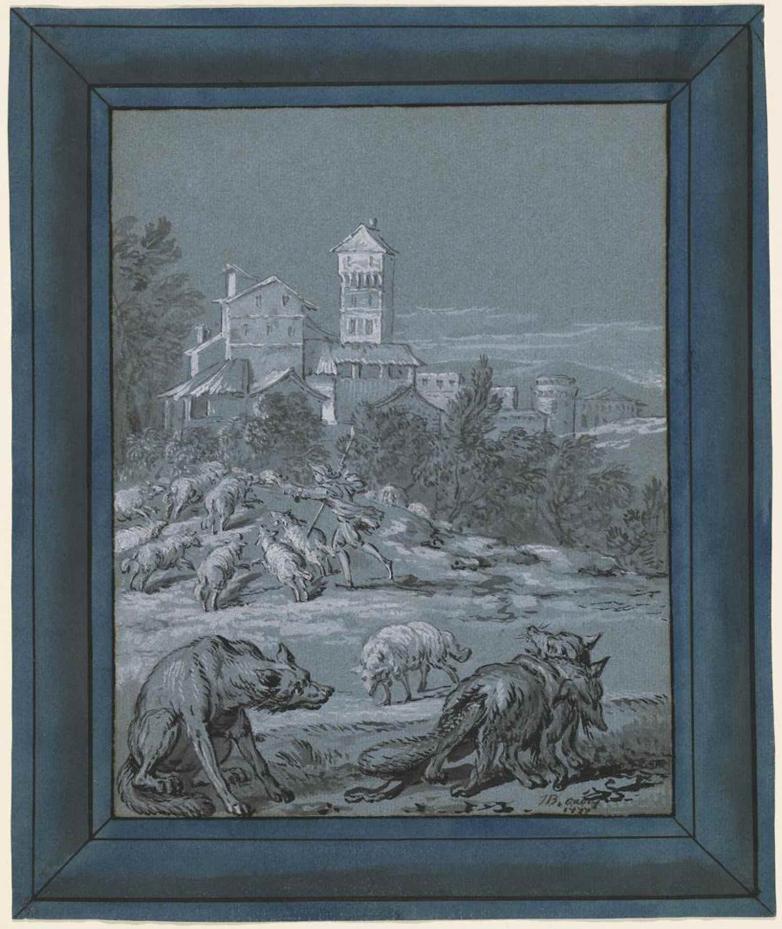Drawings on Blue Paper Made from Discarded Rags at Getty

The Wolf and the Fox, 1733. Jean-Baptiste Oudry, French (1686-1755). Black ink and gray wash heightened with white opaque watercolor on blue paper; frame design in black ink, gray wash, and blue watercolor. 31.1 x 26 cm (12 1/4 x 10 1/4 in.).
On view at the Getty Center in Los Angeles through April 28, 2024 is Drawing on Blue: European Drawings on Blue Paper, 1400s–1700s, an exhibition that dives into the history of blue paper, from its earliest use in Renaissance Italy to Enlightenment France and beyond.
The exhibition, which features nearly 40 drawings mostly from the museum’s collection, begins by tracing the origins of blue paper in northeastern Italy. Made from discarded blue rags that were pulped and formed into sheets on a mold, blue paper was first manufactured in Bologna and its earliest systematic use by artists was by painters in the Veneto region. One of the early adopters, Bartolomeo Montagna, is represented in the exhibition with The Risen Christ, a meticulously rendered study in which the artist utilized blue paper as a middle tone.
Within the span of two centuries, the production and use of blue paper quickly spread and specialized mills were established at various locations across Europe, including Spain, the Dutch Republic, and England. Due to its versatility, blue paper allowed artists to achieve nuanced chiaroscuro effects, enhance certain hues, and mimic atmospheric phenomena.
“The use of blue paper to change the visual ‘mood’ of a work of art was one of the most innovative inventions of Renaissance artists. Its distinctive aesthetic qualities have earned it a special place in the history of European draftsmanship and attracted the interest of connoisseurs and collectors through the centuries,” said Timothy Potts, Maria Hummer-Tuttle and Robert Tuttle Director of the J. Paul Getty Museum.
By the 17th century, papermakers in the Netherlands transformed the appearance of blue paper by adding dyes directly to the pulp. With the invention of the Hollander beater - a machine that produces paper pulp from plant fibers - they were able to create more evenly toned sheets with an intense hue. Colorants were often sourced from outside Europe, such as in Dutch artist Jacob Ariaensz Backer’s A Young Man with a Fur Hat which, after scientific analysis, Getty conservators learned contains traces of logwood, a dyestuff imported from the Americas.
Pastelists were major advocates of blue paper, including the Venetian artist Rosalba Carriera who preferred to source her sheets from Northern Europe rather than from the Veneto where it was readily available. Although her delicate representation of Muse is covered entirely in media, blue fibers were detected under high magnification, confirming she used blue paper to create a natural shadow effect, particularly in the figure’s cheek.
The exhibition features two recently acquired works that will be exhibited at Getty for the first time. The first, Holy Family with Saint Joseph Holding a Rose by Netherlandish artist Bartholomaeus Spranger, is one of less than 100 surviving drawings by the artist. The second is Jonah Preaching at Nineveh by German artist Johann Wolfgang Baumgartner, which is a strong example of how artists employed chiaroscuro techniques with blue paper, using its middle tone to explore nuanced effects of light and shadow.
Complementing the exhibition is a free lecture program at the Getty Center on February 25, during which Dr. Massumeh Farhad, the Ebrahimi Family Curator of Persian, Arab, and Turkish Art and Senior Associate Director of Research at Smithsonian’s National Museum of Asian Art, will offer a non-Western perspective on blue paper by focusing on its influence in Islamic art.















